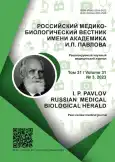Effectiveness of Surgical Treatment of Patients with Respiratory Tuberculosis Complicated with Chronic Pleural Empyema Depending on Spread of Intrapleural Pathological Alterations
- Authors: Chitorelidze G.V.1, Chashchina M.V.1, Bagirov M.A.1, Sadovnikova S.S.1, Berezovskiy Y.S.1, Papkov A.V.2
-
Affiliations:
- Central Tuberculosis Research Institute
- Ryazan State Medical University
- Issue: Vol 31, No 3 (2023)
- Pages: 357-366
- Section: Original study
- Submitted: 27.08.2022
- Accepted: 03.11.2022
- Published: 12.10.2023
- URL: https://journals.eco-vector.com/pavlovj/article/view/109880
- DOI: https://doi.org/10.17816/PAVLOVJ109880
- ID: 109880
Cite item
Abstract
INTRODUCTION: Chronic tuberculous pleural empyema (CTPE) is a severe form of tuberculous lesion characterized by a purulent-destructive process in the residual pleural cavity, gross irreversible morphofunctional specific alterations in the pleura forming within three-five months after appearance of clinical signs of pleurisy. Patients with respiratory tuberculosis (RT) complicated with pleural empyema, are the most severe contingent of patients in tuberculosis (TB) hospitals.
AIM: To study effectiveness of surgical treatment of patients with RT complicated with CTPE depending on spread of pathological alterations in the parietal pleura.
MATERIALS AND METHODS: The study included 65 patients (43 men, 66.2%, aged 23–61 years; 22 women, 33.8%, aged 26–65 years) with RT complicated with CTPE, who underwent surgical treatment in the volume of pleurectomy with decortication of lung. Patients were divided to 3 groups depending on spread of pathological alterations in the parietal pleura: group 1 (n = 40, 61.5%) with spread of CTPE not exceeding the surface area of one anatomical wall of the pleural cavity; group 2 (n = 15, 23.1%) with CTPE involving 2–3 anatomical walls of the pleural cavity; group 3 (n = 10, 15.4%) with CTPE involving all anatomical walls of the pleural cavity.
RESULTS: The effectiveness of complex treatment of patients with RT complicated with CTPE was 92.3% (n = 60). In the period from 2014 to 2021, the rate of postoperative complications after pleurectomy with decortication of lung including simultaneous resection, was 12.3%, mortality rate 0% and postoperative recurrences of empyema 7.7%. Despite adequate postoperative conservative treatment, the achievement of clinical effect and the absence of postoperative recurrences were directly proportional to the spread of intrapleural alterations. The destructive widespread forms of PT with multiple and wide-range drug resistance of mycobacterium tuberculosis are more common among the patients with subtotal and total forms of CTPE.
CONCLUSION: The obtained results evidence a high effectiveness of surgical treatment of the given category of patients irrespective of spread of pathological alterations in the pleura and lung.
Full Text
About the authors
Georgiy V. Chitorelidze
Central Tuberculosis Research Institute
Email: chitorelidze2015@yandex.ru
ORCID iD: 0000-0001-5062-9788
SPIN-code: 4301-7364
MD, Cand. Sci. (Med.)
Russian Federation, MoscowMargarita V. Chashchina
Central Tuberculosis Research Institute
Email: tsimbalyuck.rita@yandex.ru
ORCID iD: 0000-0002-0257-5145
PhD-Student
Russian Federation, MoscowMamad-Bagir A. Bagirov
Central Tuberculosis Research Institute
Email: bagirov60@mail.ru
ORCID iD: 0000-0001-9788-1024
SPIN-code: 8820-5448
MD, Dr. Sci. (Med.), Professor
Russian Federation, MoscowSvetlana S. Sadovnikova
Central Tuberculosis Research Institute
Email: sadovnikova.sv@mail.ru
ORCID iD: 0000-0002-6589-2834
MD, Dr. Sci. (Med.)
Russian Federation, MoscowYuriy S. Berezovskiy
Central Tuberculosis Research Institute
Author for correspondence.
Email: report-q@yandex.ru
ORCID iD: 0000-0001-5904-0021
Russian Federation, Moscow
Aleksandr V. Papkov
Ryazan State Medical University
Email: avpapkov@mail.ru
ORCID iD: 0000-0003-2988-990X
SPIN-code: 4902-5864
MD, Dr. Sci. (Med.)
Russian Federation, RyazanReferences
- Elkin AV, Basek TS, Kalechenkov MK, et al. Postponed outcomes of surgery treatment of extensive drug resistant pulmonary tuberculosis patients. Tuberculosis and Lung Diseases. 2015;(7):39–40. (In Russ).
- Krants IM. Surgical treatment of pulmonary tuberculosis. Glavvrach. 2018;(11):72–81. (In Russ).
- Beznosik RV, Polyanskii VK, Lyatoshinskii AV, et al. Surgical treatment of chronic tuberculous empyema of the pleura. Voenno-Medicinskij Žurnal. 2020;341(8):38–45. (In Russ). doi: 10.17816/RMMJ82361
- Polyanskiy VK, Savitskiy GG. About pyopneumothorax in patients with pulmonary tuberculosis. Voenno-Medicinskij Žurnal. 2017;338(6):48–54. (In Russ). doi: 10.17816/RMMJ73308
- Tyukhtin NS, Stogova NA, Giller DB. Bolezni plevry. Moscow: Meditsina; 2010. (In Russ).
- Opanasenko MS, Shalahai SM, Tereshkovych OV, et al. Efficiency of Different Types Parietal Pleurectomy with Decortication of the Lung with Specific and Nonspecific Pleural Diseases. Tuberculosis, Lung Diseases, HIV Infection (Ukraine). 2017;(1):39–2. (In Ukrain).
- Shirinkina AE, Burukhina LV, Sergevnin VI, et al. Osobennosti sovremennogo tuberkuleznogo plevrita v zavisimosti ot patomorfologicheskoy kartiny plevry. Aktual’nyye Problemy Gumanitarnykh i Estestvennykh Nauk. 2011;(5):198–200. (In Russ).
- Varin AA, Khanin AL, Fenster VA. Tuberculous empyema of pleura as a predictor of death in patients with pulmonary tuberculosis. Vestnik Sovremennoi Klinicheskoi Mediciny. 2015;8(1):23–6. (In Russ).
- Bryusov PG, Polyanskiy VK. Tuberkuleznaya empiyema plevry. Moscow; 2007. (In Russ).
- Popov MYu. Osobennosti diagnostiki i lecheniya empiyemy plevry tuberkuleznoy etiologii v usloviyakh fizioterapevticheskogo statsionara [dissertation]. Saint-Petersburg; 2003. (In Russ).
- Polyanskiy VK, Savitskiy GG, Lyatoshinskiy AV. K voprosu o diagnostike i khirurgicheskoy taktike pri khronicheskoy tuberkuleznoy empiyeme plevry. Tuberkulez i Sotsial’no-znachimyye Zabolevaniya. 2015;(3):62–3. (In Russ).
- Ots ON, Agkatsev TV, Perelman MI. The surgical treatment of pulmonary tuberculosis with the resistance of mycobacteria to drugs. Sechenovskiy Vestnik. 2012;(2):15–23. (In Russ).
- Giller DB, Kesaev OSh, Koroev VV, et al. The difficulties in diagnosing and treatment tactics of postresection tuberculous pleural empyema with bronchopleural fistula. Russian Electronic Journal of Radiology. 2019;9(3):209–14. Available at: http://rejr.ru/volume/35/22.pdf. Accessed: 2022 November 17. (In Russ). doi: 10.21569/2222-7415-2019-9-3-209-214
- Nikonov SD, Smolentsev MN, Krasnov DV, et al. Photodynamic therapy in tuberculous pleural empyema. Tuberculosis and Lung Diseases. 2021;99(5):51–6. (In Russ). doi: 10.21292/2075-1230-2021-99-5-51-56
- Zeng X, Yue W, Ye S, et al. Evaluation of thoracic surgery as a treatment approach in patients with rifampin-resistant chronic tuberculous empyema. J Bras Pneumol. 2022;48(4):e20220074. doi: 10.36416/1806-3756/e20220074
Supplementary files











